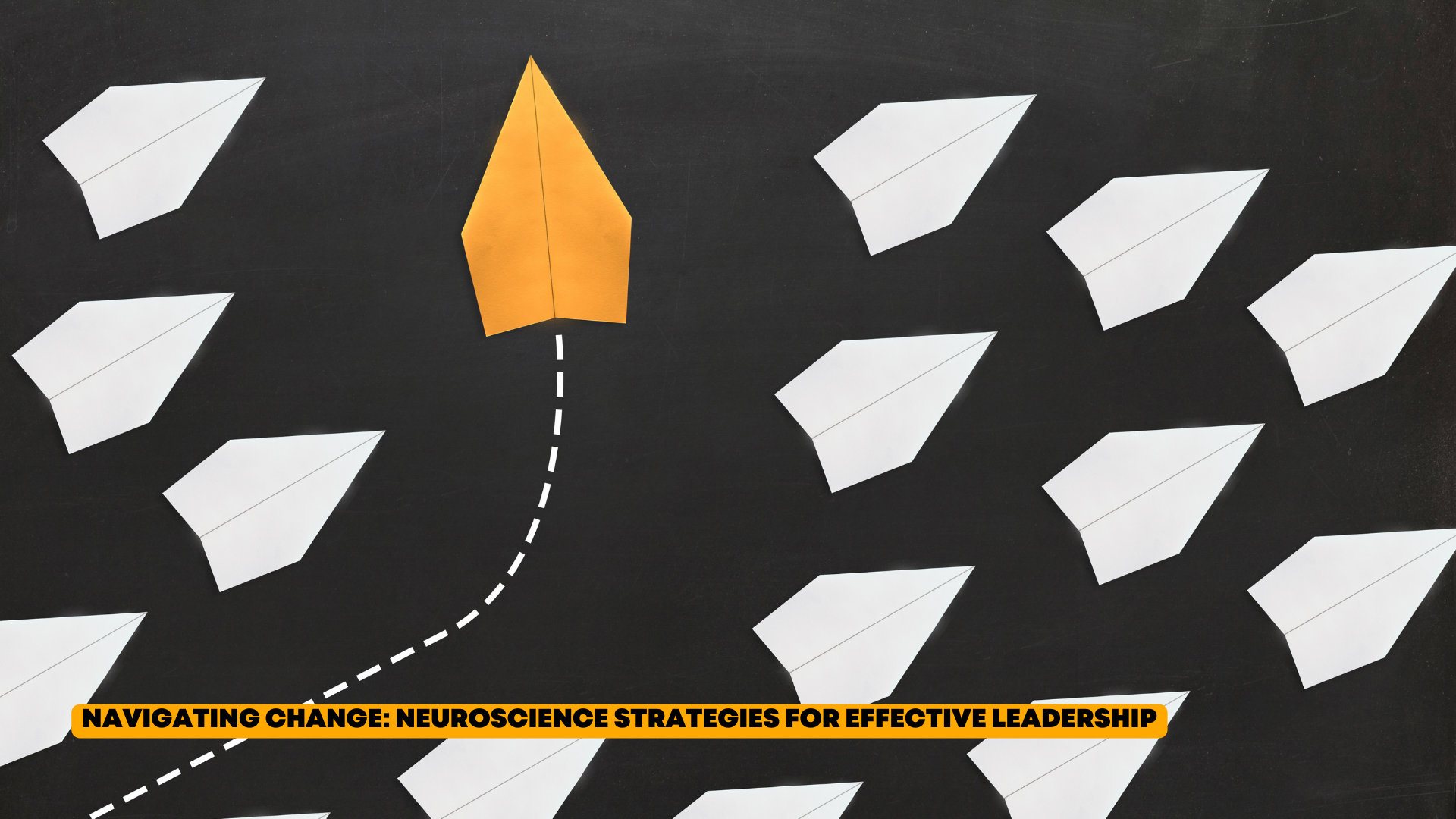Neuroscience Strategies for Successful Change Management
Understanding how the brain works during change can make you a rockstar change manager. Imagine if you knew exactly how to get your team to embrace new ideas like they’re the next big thing since sliced bread. (By the way, can we all agree that sliced bread is still pretty awesome?)
In this article, we’re diving deep into the brainy bits that can make all the difference. We’ll explore why people resist change (hint: it’s not just because they like the status quo), how emotions play a massive role, and practical tips to make your change management as smooth as a jazz solo.
Understanding Change in Organizations
Imagine your organization is a big, comfy couch. Change management is like the movers who help you reposition that couch (without breaking your back or scratching the floors) when you decide the living room needs a refresh. It’s all about the process, tools, and techniques to manage the people side of change to achieve the required business outcome.
So, why should we care about change management? Because without it, your carefully laid plans can unravel faster than a cheap sweater. Successful change management is the secret sauce that turns ambitious goals into reality. It ensures that everyone is on the same page, moving in the same direction and that the transformation sticks. When done right, it boosts productivity, enhances employee morale, and makes your organization more adaptable to future changes. In short, it’s the MVP of organizational success.
Common Challenges in Change Management
Change management isn’t all rainbows and unicorns. It’s more like navigating a ship through a storm while juggling flaming torches. Here are some of the biggest challenges that can throw a wrench in the works:
1. Resistance to Change:
Ah, resistance. The arch-nemesis of change. People often resist change because it’s uncomfortable, scary, and requires effort. It’s like trying to get a cat to take a bath. They’re not having it! Understanding why people resist is crucial. Spoiler alert: It’s not because they’re lazy or stubborn. It’s usually because change disrupts their routine, and our brains love routine. Change can trigger a fear response, and nobody likes feeling afraid.
2. Communication Barriers:
Ever played the game of Telephone? One person whispers a message to the next, and by the time it reaches the last person, it’s completely garbled. That’s what happens when communication breaks down during change. Clear, consistent, and transparent communication is key to avoiding misunderstandings and keeping everyone on board. If your message isn’t getting through, it’s like trying to steer a ship with a blindfold on. Not ideal!
3. Lack of Engagement:
Picture this: You’re trying to start a dance party, but everyone’s sitting on the sidelines, scrolling through their phones. Without engagement, your change initiative is doomed to flop. Getting people involved and excited about the change is essential. This means not just telling them what’s happening but also listening to their concerns, involving them in the process, and making them feel like they’re part of something awesome.
Change management is vital for steering your organization toward success, but it comes with its fair share of challenges. The good news? Neuroscience offers some brilliant strategies to tackle these hurdles head-on. Up next, we’ll dive into the fascinating world of brain science and how it can make change management a breeze (or at least, less of a hurricane).
Brain Functions and Decision-Making
Our brains are like supercomputers, processing tons of information every second. When it comes to making decisions, two parts of the brain play key roles: the prefrontal cortex and the amygdala. The prefrontal cortex is the rational thinker, the CEO of the brain, weighing pros and cons and making logical choices.
On the flip side, the amygdala is the emotional powerhouse, responding to stress and triggering the fight-or-flight response. When faced with change, these two can end up in a tug-of-war, with the amygdala often screaming, “Danger, Will Robinson!” while the prefrontal cortex tries to keep calm and carry on.
Emotional Responses to Change
Change can be an emotional rollercoaster. Our brains are hardwired to prefer stability and predictability because it feels safe. When change happens, it can trigger feelings of fear, anxiety, and even anger. These emotional responses are totally natural and can be traced back to our caveman ancestors who needed to be wary of anything new and potentially dangerous (like, say, a saber-toothed tiger). Understanding these emotional responses is key to managing them effectively.
1. How Neuroscience Helps in Understanding Resistance
Remember that resistance to change we talked about earlier? Neuroscience gives us the tools to understand why people resist change. It’s not just stubbornness; it’s a deep-seated survival mechanism. When people resist change, their brains are essentially trying to protect them from the unknown. By understanding this, we can develop strategies to reduce fear and build trust, making the transition smoother.
2. How Neuroscience Aids in Acceptance
On the flip side, neuroscience also helps us understand how to foster acceptance. Creating a positive emotional response to change can engage the brain’s reward system, making people more open and willing to embrace new ways of working. This involves creating a sense of purpose, providing support, and celebrating small wins along the way.
In a nutshell, neuroscience provides us with a blueprint for navigating the complex landscape of human behavior during times of change. By leveraging these insights, we can turn resistance into acceptance and make change not just manageable but downright exciting.
Neuroscience Principles in Organizational Change
The Role of Emotions in Change
It’s time to get emotional—literally! Emotions play a HUGE role in how we handle change. You can thank Dr. John P. Kotter for shining a light on this. He’s like the Yoda of change management, but with fewer riddles and more practical advice.
Insights from Dr. John P. Kotter on Emotions and Change Management: Dr. Kotter emphasizes that emotions are the fuel that drives change. Think of it this way: If change is a car, emotions are the gas. Without emotional buy-in, your change initiative is going nowhere fast. Kotter suggests tapping into positive emotions like excitement and inspiration to propel your team forward. Create a vision that’s not just clear but also emotionally compelling. When people feel passionate about the change, they’re more likely to jump on board and stay committed.
The Brain’s Response to Change
Next up, let’s talk about how our brains react to change. Dr. David Rock and Jeffrey Schwartz are the rockstars here, and they’ve got some fascinating insights.
Dr. David Rock and Jeffrey Schwartz’s Perspectives on Brain Science and Change: Rock and Schwartz explain that our brains crave certainty and control. When change disrupts these, the brain perceives it as a threat. This triggers the amygdala, our trusty fear center, which can cause us to resist the change instinctively. But here’s the kicker: You can actually rewire the brain to respond more positively to change. It’s called neuroplasticity, which is a fancy way of saying our brains are adaptable and can form new pathways.
By consistently reinforcing positive experiences and outcomes related to the change, you can help your team build new neural connections that support the new way of doing things. Think of it as upgrading your brain’s operating system—less Windows 95, more sleek and modern.
Overcoming Resistance through Neuroscience
Now, let’s tackle that pesky resistance head-on. Dr. Lisbeth Nielsen has some fantastic research on why employees resist change and how to overcome it.
Dr. Lisbeth Nielsen’s Research on Employee Resistance: Nielsen’s work shows that resistance often stems from fear and uncertainty. But here’s the good news: By understanding these fears, you can address them directly. Nielsen suggests that transparency and communication are key. Share the “why” behind the change, not just the “what.” People need to understand the bigger picture and how the change benefits them personally.
Another tip? Engage your team in the process. When people feel like they have a say, they’re less likely to resist. It’s like letting them pick the toppings for the office pizza party—they’re more invested in the outcome when they’ve had a hand in shaping it.
Practical Applications of Neuroscience in Change Management
Creating a Brain-Friendly Change Environment
Let’s talk about creating a brain-friendly change environment, shall we? It’s like setting up a cozy coffee shop vibe but for organizational change—comfy chairs, good vibes, and a menu that everyone loves. Dr. Tali Sharot has some top-notch strategies for making this happen using brain science.
Strategies from Dr. Tali Sharot on Managing Change Through Brain Science: Dr. Sharot emphasizes the power of positive reinforcement. Our brains respond much better to rewards than to threats (shocking, right?). So, focus on highlighting the benefits and positive outcomes of the change. Celebrate small wins to keep the momentum going. It’s like giving your team a high-five every step of the way.
Another tip? Use the power of social proof. People are more likely to embrace change if they see their peers doing the same. So, spotlight early adopters and their successes. It’s like starting a dance party—once a few people start grooving, everyone else wants to join in.
Enhancing Leadership for Change
Next, let’s chat about leadership. Because, let’s face it, change starts at the top. Dr. Andrew Huberman has some stellar insights on how leaders can use neuroscience to steer their ships through stormy waters.
Dr. Andrew Huberman’s Insights on Applying Neuroscience to Leadership: Huberman suggests that leaders need to be masters of emotional regulation. If you’re calm and collected, your team will follow suit. It’s all about mirror neurons—your team’s brains will pick up on your emotional state and mirror it. So, if you’re freaking out, guess what? They will too.
Another nugget of wisdom is about clarity and vision. Our brains love clear goals and direction. Paint a vivid picture of the future and how the change will lead to a better place. Make it as detailed and tangible as possible. Think of it as creating a roadmap for a road trip—everyone wants to know where the pit stops are and what snacks to bring.
Techniques for Sustaining Change
Finally, let’s dive into how to make change stick. Because what’s the point of all this effort if things just go back to the way they were? Dr. Mark Waldman has some killer strategies for ensuring long-term change through neuroscience.
Dr. Mark Waldman’s Strategies for Long-Term Change Through Neuroscience: Waldman’s secret sauce? Mindfulness and habit formation. Regularly practicing mindfulness can help rewire the brain to be more adaptable and open to change. It’s like giving your brain a daily workout. Encourage your team to take a few minutes each day for mindfulness exercises. It sounds woo-woo, but the science backs it up!
He also stresses the importance of embedding new habits. The brain loves routines, so turn new behaviors into habits. Use cues, routines, and rewards to solidify these changes. It’s like training a puppy—consistent practice, patience, and plenty of treats.
Case Studies and Examples
Time to put theory into practice and see some real-world magic! Let’s dive into some juicy case studies and examples that show how neuroscience can be a game-changer in organizational transformation.
Successful Organizational Changes Using Neuroscience
First up, let’s talk success stories—those feel-good tales that make you believe in the power of brain science! Harvard Business Review has a fantastic case study on this.
Case Study from the Harvard Business Review on Leveraging Neuroscience
In this case study, a mid-sized tech company faced significant resistance to a major organizational change. They were introducing a new project management system, and let’s just say, the initial reception was colder than a polar bear’s toenails. Employees were grumbling, productivity was plummeting, and morale was circling the drain.
The company decided to apply some of Dr. Tali Sharot’s strategies. They started by focusing on positive reinforcement—celebrating small victories and highlighting how the new system made life easier for early adopters. They also used social proof, showcasing stories from employees who were thriving with the new system.
Within months, the tide turned. Resistance melted away, adoption rates soared, and the company not only weathered the change but came out stronger on the other side. It was like watching a blockbuster transformation montage—cue the inspirational music!
Lessons Learned from Failed Change Initiatives
Now, let’s switch gears and talk about the not-so-successful stories. Because let’s be real, we learn a ton from our flops. Understanding what went wrong can be just as enlightening as celebrating wins.
Analysis of Common Pitfalls and How Neuroscience Could Have Addressed Them
Take, for example, a large financial institution that attempted a massive restructuring. They rolled out the change with the finesse of a bull in a china shop—no clear communication, no involvement from employees, and zero focus on emotional responses. The result? A spectacular face-plant. Employee resistance was through the roof, productivity took a nosedive, and turnover rates skyrocketed.
So, what went wrong? They ignored the basic principles of neuroscience. Here’s how applying brain science could have turned the tide:
Communication Breakdown: They didn’t explain the “why” behind the change. Neuroscience teaches us that understanding the purpose reduces fear and resistance. By clearly communicating the vision and benefits, they could have engaged the rational, decision-making parts of the brain.
Emotional Neglect: They failed to address the emotional aspect of change. As Dr. Kotter highlighted, emotions are the fuel for change. Acknowledging fears, providing support, and fostering positive emotions could have mitigated the backlash.
Lack of Engagement: Employees felt like change was being done to them, not with them. Engaging employees in the process and making them feel like active participants would have leveraged their mirror neurons, creating a more collaborative atmosphere.
By learning from these missteps and integrating neuroscience principles, organizations can avoid common pitfalls and set themselves up for successful transformations.
Wow, what a journey we’ve been on!
Let’s take a quick breather and recap the brainy goodness we’ve covered:
Understanding Change in Organizations: We explored what change management is all about and why it’s crucial for organizational success. We also looked at the common challenges like resistance, communication barriers, and lack of engagement.
We dove into the basics of neuroscience relevant to change management, including brain functions and emotional responses to change. We learned how neuroscience helps us understand human behavior, especially resistance and acceptance.
We discussed the pivotal role of emotions, the brain’s response to change, and how to overcome resistance using neuroscience insights from experts like Dr. John P. Kotter, Dr. David Rock, Jeffrey Schwartz, and Dr. Lisbeth Nielsen.
We explored creating a brain-friendly change environment, enhancing leadership for change, and techniques for sustaining long-term change with strategies from Dr. Tali Sharot, Dr. Andrew Huberman, and Dr. Mark Waldman.
We saw real-world applications of neuroscience in successful organizational changes and learned valuable lessons from failed change initiatives.
Now, it’s time to take these insights and run with them! Leaders, it’s your moment to shine. Embrace the power of neuroscience in your change management strategies. Use the brainy tips and tricks we’ve discussed to turn potential chaos into a well-oiled machine. Remember, understanding the science behind how we think, feel, and act can be the secret sauce to making change not just manageable but downright transformative.
The transformative potential of neuroscience in managing organizational change is immense. By leveraging the latest brain science, you can create a more adaptive, resilient, and successful organization. So, don’t shy away from the brainy stuff—embrace it, apply it, and watch your organization thrive. Here’s to making change less of a headache and more of a triumph!














